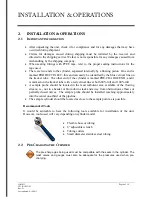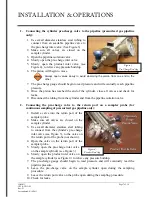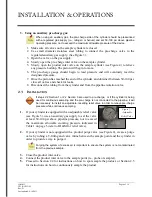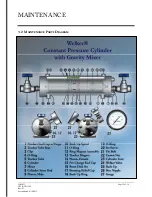
MAINTENANCE
IOM-013
Page 11 of 18
CP2 & CP5GM
Rev: D
Last updated: 4/14/2011
3. MAINTENANCE
3.1 G
ENERAL
Prior to maintenance or disassembly of the unit, it is advisable to have a repair kit handy
in case of unexpected wear or faulty seals.
We recommend that the unit have annual maintenance under normal operating
conditions. In the case of severe service, dirty conditions, excessive cycling usage, or
other unique applications that may subject the equipment to unpredictable
circumstances, a more frequent maintenance schedule may be appropriate.
Recommended Tools
It would be advisable to have the following tools available for installation of the unit.
However, tools used will vary depending on cylinder model and connectors used.
Small hex key set
6” adjustable wrench
10” adjustable wrench
10” channel lock pliers
Fine-grit sandpaper
Flat blade screwdriver
Torque wrench
O-Ring kit
New seals supplied in spare parts kits are not lubricated. They should be lightly coated
with lubrication grease (silicone grease or other) before they are installed into the
equipment. This helps in the installation of the seals while reducing the risk of damage
when positioning them on the parts. After the seals are installed, some additional
lubrication can be applied to shafts or cylinder inner diameters to allow smooth transition
of parts. While lubrication should be thorough, only a minimal amount should be applied.
Wipe excess lubrication from the seals, as it may have an adverse effect on sampling.
In the case of constant pressure cylinders, the lubrication grease should be applied
sufficiently but lightly (Krytox
®
is preferred). When using lubrication other than Krytox,
wipe excess lubrication from the seals as it may have an adverse effect on some
analytical instrument results.
Do not dig into the metal surfaces of the parts when removing O-rings from the O-ring
grooves. Scratching the sealing surface can result in a leak. If necessary, dig into the O-
ring, and replace it during reassembly. If the sealing surface becomes damaged, use a
600-grit wet sandpaper strip to smooth the surface, and then clean it. Check the ball
bearing for any signs of wear or damage. Replace if necessary.



















